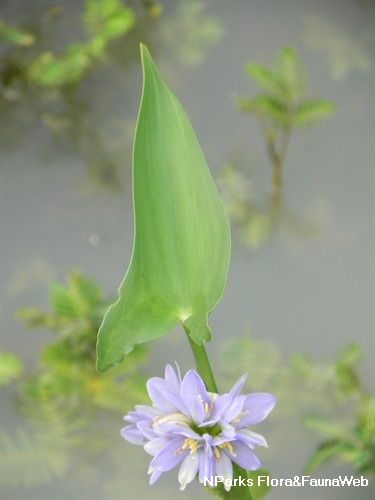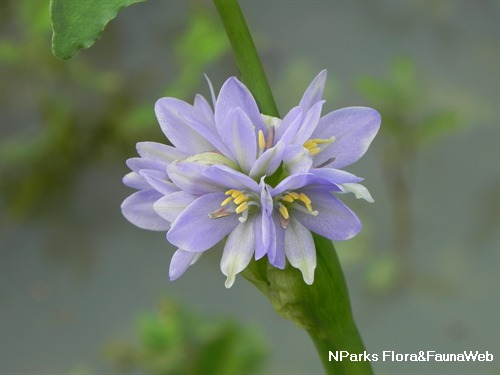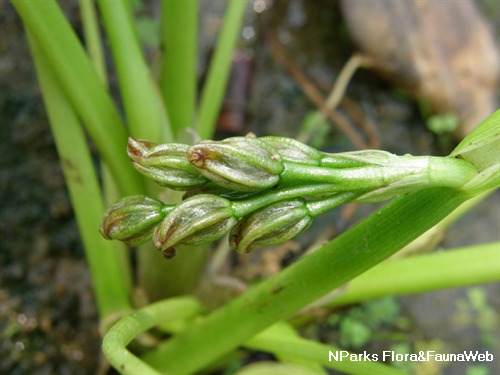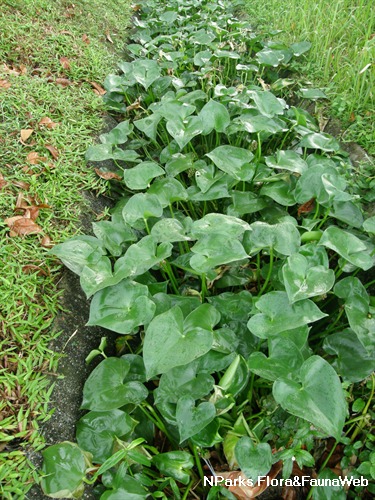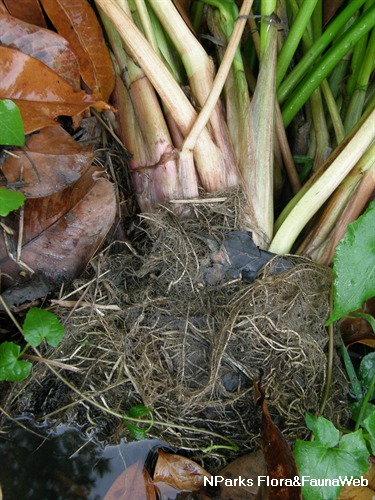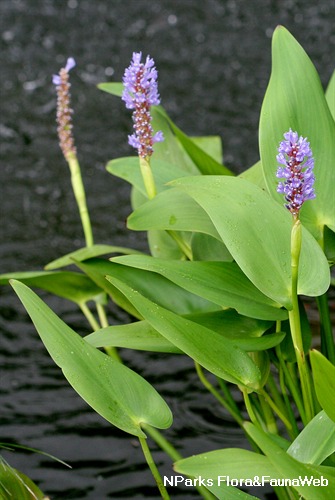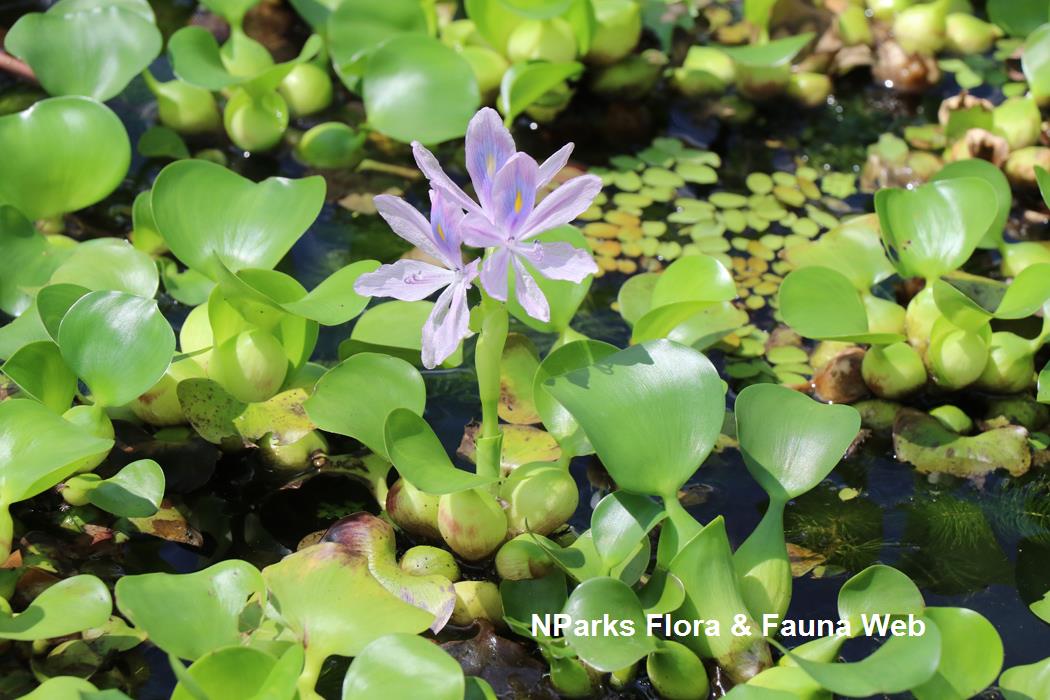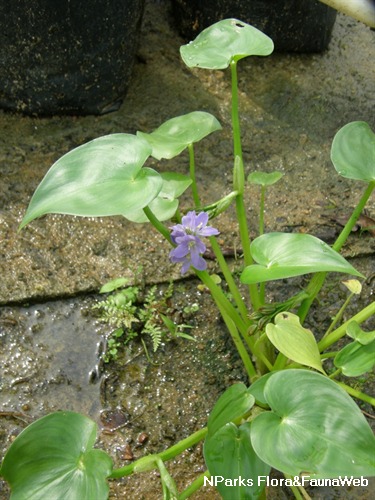
Back
Pontederia vaginalis Burm.f.
| Family Name: | Pontederiaceae |
| Synonyms: | Gomphima vaginalis (Burm.f.) Raf., Monochoria vaginalis (Burm.f.) C.Presl ex Kunth, Monochoria pauciflora (Blume) Kunth in Enum. |
| Common Name: | Oval-leaved Pondweed, Heartleaf False Pickerelweed |
Name
Classifications and Characteristics
| Plant Division | Angiosperms (Flowering Seed Plants) (Monocotyledon) |
|---|---|
| Plant Growth Form | Aquatic & Hydrophyte (Emergent Aquatic, Waterside / Marginal) |
| Lifespan (in Singapore) | Perennial |
| Mode of Nutrition | Autotrophic |
Biogeography
| Native Distribution | South Asia, throughout Southeast Asia, extending to China, Japan, Fiji islands and northern Australia |
|---|---|
| Native Habitat | Terrestrial (Riverine) |
| Preferred Climate Zone | Tropical, Sub-Tropical / Monsoonal |
Description and Ethnobotany
| Others - Plant Morphology | Growth Form: Extremely variable in height, ranging from 3 to over 50 cm, Monochoria vaginalis is a herbaceous plant that usually grows as an annual but may persist for more than a year in permanent water. Erect, and occasionally creeping, the plant may be emergent or floating in freshwater.Habitat: M. vaginalis is found in habitats, such as in swamps and shallow pools, along ditches and on canal banks. Occurring at up to 1500 m altitude, it is commonest in eutrophic water but also in brackish and oliogotrophic water. It is very often found in rice fields, where the plant is considered a weed that can reduce rice yields considerably if allowed to grow to high population densities.Stem:Creeping or ascending, rarely forming rhizomes.Foliage: Leaves long, linear or lanceolate to ovate in shape, each with petiole up to 50 cm long.Flowers: Flowers are borne on terminal inflorescences that have 2-50 cm long stalks that become strongly deflexed when flowers develop into fruits. Inflorescence stalks terminate with two opposed modified leaves, known as spathes. The dominant lower spathe is leaf-like, linear or lanceolate to ovate or cordate in shape, with a sheath and may enclose the upper spathe. Flowers are bisexual, showy and blue to white in colour, with six stamens (= male reproductive parts of a flower, each consisting of the anther and filament), of which five are yellow, one blue.Flowering takes place in the morning, withering within a day.Fruits: Fruit a capsule that is ellipsoidal to subglobular in shape, that dehisces through the compartments within, containing many seeds. Seeds brown to black in colour, cylindrical to ovoid or subglobular in shape, each with 8-14 longitudinal ribs resembling wings.Following the fertilisation of the inflorescence, the weight of the developing young fruits pulls the structure downwards such that the development of the fruits takes place in water. Seeds subsequently germinate in water as well, upon liberation from the fruit.Cultivation: M. vaginalis may be propagated by seed or from side shoots.Etymology: Monochoria is Greek for “single-membrane”, in reference to the persistent covering of the fruit, while the specific epithet, vaginalis, refers to the sheaths covering the leaf-like spathes of the inflorescences. |
|---|---|
| Ethnobotanical Uses | Edible Plant Parts : Edible Leaves, Edible Flowers, Edible Stems Food (Fruit or Vegetable) (Herb or Spice) Others: Food: M. vaginalis is eaten as a vegetable in southern and eastern Asia. The leaves and stems are cooked before consumption but the inflorescences are sometimes eaten raw in Southeast Asia. Rhizomes of M. vaginalis are eaten in the Philippines, although the plant seldom produces rhizomes. Medicine: Leaves of M. vaginalis are pounded and mixed with turmeric (Curcuma longa) and Portulaca pilosa, then applied to boils after they have burst. Juice from the roots is used to treat stomach and liver ailments, as well as asthma and toothache. Juice from the leaves is sometimes used to cure coughs. Other Uses: M. vaginalis is used as an ornamental plant. |
Landscaping Features
| Desirable Plant Features | Ornamental Flowers |
|---|---|
| Landscape Uses | Riverine, Aquarium / Aquascape |
Fauna, Pollination and Dispersal
| Seed or Spore Dispersal | Abiotic (Water) |
|---|
Plant Care and Propagation
| Light Preference | Full Sun |
|---|---|
| Water Preference | Lots of Water |
| Rootzone Tolerance | Waterlogged Soils (Drains Site) |
| Propagation Method | Seed, Sucker |
Foliar
| Mature Foliage Colour(s) | Green |
|---|---|
| Foliar Shape(s) | Non-Palm Foliage (Lanceolate, Linear) |
Non - Foliar and Storage
| Stem Type & Modification | Herbaceous |
|---|
Floral (Angiosperm)
| Flower & Plant Sexuality | Bisexual Flowers |
| Flower Colour(s) | Blue, White |
|---|---|
| Flowering Period | Free-Flowering |
| Flowering Opening Time | Daytime |
| Flower Lifespan on Plant | 1 Day |
| Flowering Habit | Polycarpic |
Fruit, Seed and Spore
| Mature Fruit Colour(s) | Black, Brown |
|---|---|
| Fruit Type | Dehiscent Dry Fruit , Capsule |
Image Repository
Others
| Master ID | 30140 |
|---|---|
| Species ID | 4449 |
| Flora Disclaimer | The information in this website has been compiled from reliable sources, such as reference works on medicinal plants. It is not a substitute for medical advice or treatment and NParks does not purport to provide any medical advice. Readers should always consult his/her physician before using or consuming a plant for medicinal purposes. |

